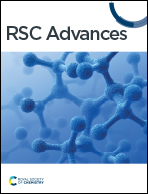Effect of (H2O)n (n = 0–3, 13) on the NH3 + OH reaction in the gas and liquid phases†
Abstract
We studied the effect of water clusters on the NH3 + OH reaction at both the DFT and CCSD(T) levels. The calculated rate constants for the pure reaction are 2.07 × 10−13 and 1.35 × 10−13 cm3 molecule−1 s−1 in the gas and liquid phases, respectively, and the gas-phase rate constants are consistent with the corresponding experimental result (1.70 × 10−13 cm3 molecule−1 s−1), while the liquid-phase rate constants are slightly smaller than the experimental value (5.84 × 10−12 cm3 molecule−1 s−1). In the gas phase, the presence of (H2O)n (n = 1–3) decreases the rate constant compared to the pure NH3 + OH reaction, and these results are in agreement with many reported H2O-catalyzed reactions. For the liquid phase reaction, compared with the case of n = 0–3, when the size of the water molecule cluster surrounding the OH radical is n = 13, the rate constant of the title reaction increases. Our study also shows that proton transfer is also a factor which accelerates the liquid phase NH3 + OH reaction.



 Please wait while we load your content...
Please wait while we load your content...